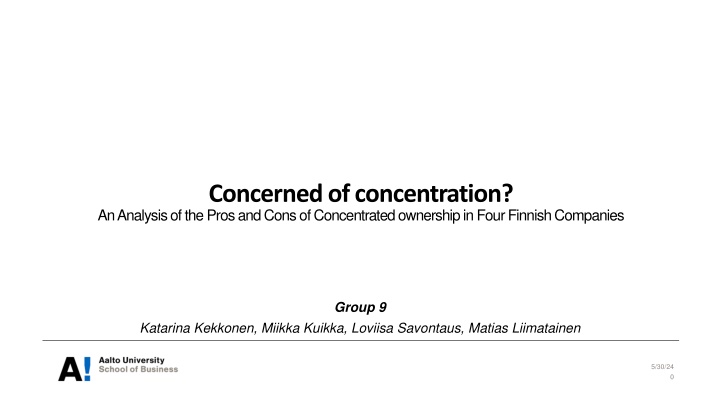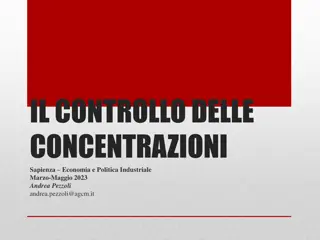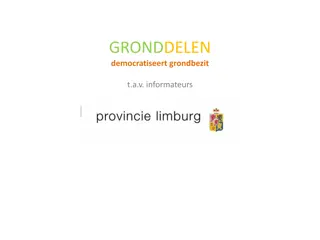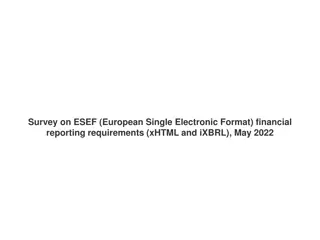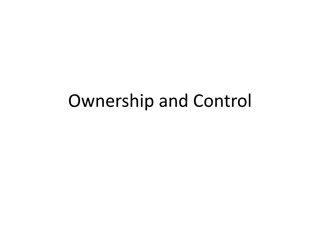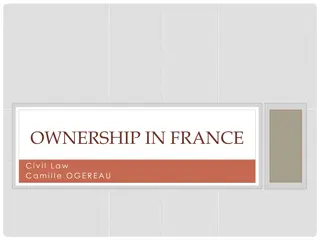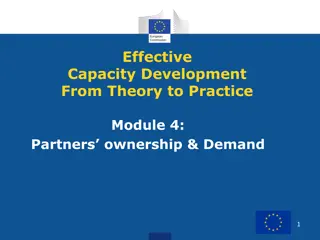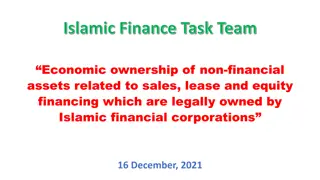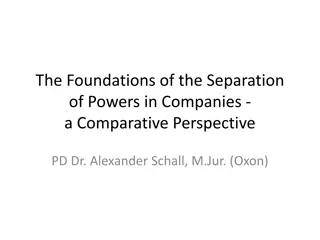Analysis of Ownership Concentration in Finnish Companies
Ownership concentration in firms can have both positive and negative impacts on performance and governance. This analysis delves into the pros and cons of concentrated ownership in four Finnish companies, exploring the implications for stakeholders and overall market dynamics.
Download Presentation

Please find below an Image/Link to download the presentation.
The content on the website is provided AS IS for your information and personal use only. It may not be sold, licensed, or shared on other websites without obtaining consent from the author.If you encounter any issues during the download, it is possible that the publisher has removed the file from their server.
You are allowed to download the files provided on this website for personal or commercial use, subject to the condition that they are used lawfully. All files are the property of their respective owners.
The content on the website is provided AS IS for your information and personal use only. It may not be sold, licensed, or shared on other websites without obtaining consent from the author.
E N D
Presentation Transcript
Concerned of concentration? An Analysis of the Pros and Cons of Concentrated ownership in Four Finnish Companies Group 9 Katarina Kekkonen, Miikka Kuikka, Loviisa Savontaus, Matias Liimatainen 5/30/24 0
Introduction Ownership concentration refers to a significant internal governance mechanism in which owners can control and influence the management of the firm to protect their interests. Large blockholders have stronger incentives to monitor the firm and because of greater incentive alignment between owners and managers. If the owners aim to maximize the market value of the firm, implications of ownership concentration include: I. more monitoring II. reduced agency costs, and III. higher expected profits and share prices If the owners have other goals than value maximization, ownership concentration may also have adverse effects from the viewpoint of minority investors, due to: I. access to insider information II. excess expenditure according to personal preferences, and III. entrenchment of managers 5/30/24 1
Theoretical Background Concentrated Ownership Source: Ownership Structure and Value of the Largest European Firms: The Importance of Owner Identity. Pedersen & Thomsen (2003) Portfolio Investor Family Government Organization Ownership Structure and Economic Performance in the Largest European Companies. Thomsen & Pedersen (2000) PROs CONs Concentrated ownership and firm performance: does family control matter? Singal & Singal (2011) Beneficial implications of concentrated ownership Reduced agency costs Improved firm performance Increased strategic focus Tunneling and propping Centralization of decision- making power Harmful implications of concentrated ownership Private benefits and minority shareholder oppression Negative entrenchment effect Weak governance Lack of transparency Tunneling Centralization of decision- making power Ownership as a form of corporate governance. Connelly et al. (2010) Management Ownership and Firm Value: An Empirical Analysis. Morck et al. (1988) Tunneling and propping: A justification for pyramidal ownership. Riyanto & Toolsema (2007) A Survey of Blockholders and Corporate Control. Holderness (2001) Concentration of ownership Optimized firm performance Strong shareholders, weak outside investors. Guti rrez & Lacave (2018) The realization of PROs and CONs heavily affected by contextual factors 5/30/24 2
There is a trend of re-concentration of ownership to institutional investors Institutional investors have increased their share of equity ownership There are significant differences between countries There has been a stable trend of institutional investors holding a larger share of equity capital market Driven especially by the increase in the largest three owners, that are Blackrock, Vanguard and State Street Trend is caused by increasing AUM in index portfolios -> Institutions have needed to become more active owners from a governance perspective Large differences between countries Finland is middle of the pack > relevant issue here Source: OECD, HBR 5/30/24 3
Ownership Categories Family Portfolio Investor Organization Government Long-term orientation and stewardship capabilities Reputational benefits and increased market confidence Active involvement Tunneling and propping Vertical integration & supply chain opportunities Taxation and transfer pricing Risk sharing Access to capital Propping Extraction of wealth at the expense of minority shareholders Loss of flexibility Risk of deficient mutual monitoring Tunnelling Government protection (e.g. entry barriers) Lower cost of capital Unique human and other resource capital Long-term orientation and stewardship capabilities Greater entrepreneurial and innovative activity Lower transactions costs Lower agency costs PROs Reduced board independence and risk of bias Exit risk Personal benefits at the expense of minority shareholders High degree of bureaucracy in decision-making Decreased firm value Personal benefits at the expense of minority shareholders Biased and suboptimal decision-making Reduced board independence CONs Source: Ownership Structure and Value of the Largest European Firms: The Importance of Owner Identity. Pedersen & Thomsen (2003) 5/30/24 4
Concentrated Ownership Can Help Alleviate Agency Costs Overview of Agency Ownership structure affects agency costs Some types of ownerships have been shown to reduce agency issues Private Equity Family ownership Effect on firm performance? Owners Board Caused by the higher incentive & ability to monitor holdings Emergence of the stewardship theory Independent board members should tackle horizontal governance risks, but what are the incentives for value creation Management Source: Jensen & Meckling 1976, Cummings et al 2010; Davis et. al. 1997 5/30/24 5
Controlling shareholder can use their influence on tunnelling and propping resources Pyramidal ownership: + Enables efficient propping, which can help lowel-level firms if they are in financial distress Makes tunnelling more feasible, potentially harming minority shareholders outside investors may become wary of investing Benefits might only be realized if investors underestimate the extent of tunneling Horizontal ownership: + Less complexity and clearer management incentives + Lower risk of tunneling, leading to higher investor confidence Limited ability to prop up struggling subsidiaries higher risk of bankruptcy if economic difficulties are encountered Tunneling: Transfer of resources from lower- level firms to higher-level firms in a pyramidial structure Propping: Transfer of resources from higher- level firms to lower-level firms, usually to avoid financial distress The balance between benefits of propping and risks of tunneling impact optimal ownership structure (pyramidal vs horizontal) Source: Tunneling and propping: A justification for pyramidal ownership. Riyanto & Toolsema (2008) 5/30/24 6
EU vs US Contextual Influence on Ownership Europe US Concentrated ownership counts 44% of listed firms and 16% of biggest firms. Concentrated ownership counts over 50% of listed firms and majority of top 50 firms. Ownership structure Passive investors are protected from controlling owners and inside management. Protecting shareholders from management in a way favourable for majority owners. Legal framework Minority shareholder expropriation Legal framework mitigates some of the issues. Higher level of expropriation which is due to mechanism that separate ownership and control rights. Monitoring Shareholders are not as much incentivised to monitor management. Higher controlling shareholder benefits such as monitoring and appreciating long-term value. Source: Strong shareholders, weak outside investors. Guti rrez & Lacave (2018) 5/30/24 7
& Family Ownership Overview of the firm Largest shareholders of Kempower 27.05.2024 Founded in 2018 Kempower s vision is to create the world s most desired EV fast charging solutions Product portfolio consists of EV charging solutions The firm pursues an innovation driven growth strategy founded on international expansion and organic growth Ownership Considerations Weakened governance and centralized decision-making hindering innovation Strategic risk arising from the family owner s personal interest; owner s risk aversion conflicting with the high-risk growth strategy Poor quality and accuracy of decision- making due to strong control power of Kemppi family Increased risk for minority shareholders due to risk of inefficient decision-making Long-term strategic orientation in decision-making and stability Incentive to drive firm performance and maximize value creation due to large personal investment Reduced agency costs supported by the long reign of current CEO Centralized decision-making increasing responsiveness to market changes Kemppi Group Oy 61.93% Varma Mutual Pension Insurance Company 4.63% Nordea Funds 1.11% Evli Fund Management Company 0.93% Ilmarinen Mutual Pension Insurance Company 0.91% Other 30.49% 5/30/24 8
Fortum & State Ownership Overview of Fortum Ownership considerations Transparency of remuneration and governance reports is at an appropriate level One of the largest energy companies in the Nordics Fortum s strategic priorities are to deliver reliable clean energy and drive decarbonization Although Finland has comparatively few companies with majority ownership, Finnish State has majority shareholding (51.26 %) of Fortum s shares From state s perspective, large shareholding is argued due to strategic interest for Finland, with ownership safeguarding accessibility Effort to maintaining balance between commercial success and public goals in the incentive structures to align management s interests with shareholders Although board scomposition is mostly appropriate, state s influence (e.g. compensation scandal) is limiting board s ability to perform its duties effectively Balancing the interests of various stakeholders (particularly minority shareholders) has proven to be challenging due to conflicting objectives Negative impact to both internal (low number of committees) and external governance mechanisms (little competition to reduce managerial slack) Source: OECD 5/30/24 9
Puuilo & Portfolio Investor Ownership Puuilo is (again) a founder-led company after a PE-exit Overview of the firm Ownership considerations Puuilo is a Finnish discount retailer with around 40 stores, offering e.g. building supplies, tools, HVAC and electrical accessories. The firm has revenues of ~340 EURm and EBITDA of ~56 EURm Founder is the largest owner for the first time on over 10 years Markku has trained to let go in the last ~15 years , left the board in the last AGM Mostly passive owners from a value creation perspective who takes the driver's seat and manages closely Horizontal governance of highest importance with the firm institutional owners of Puuilo should be able to manage these risks Ownership of the board is limited management team does slightly better Puuilo has gone through ownership transitions Founded by Markku Tuomaala Investment by Sentica Investment by Adelis IPO 1982 2011 2015 2021 5/30/24 10
Kesko & Organization Ownership Might K-Retailers drive their own interest? Overview of Kesko Ownership considerations Kesko Oyj is a Finnish trading sector company that operates in grocery, building and technical, and car trade. Chain model where idependent entrepreneurs act as K- retailers 46 % of net sales comes from sales to K-retailers Market cap of 7.1 billion EBITDA 1245.4 million (31.12.2023) K-Retailers Association with its related parties is the biggest shareholder in Kesko, and controls 7.5% of the shares and 19.5% of the votes in the company. Many individual K-retailers are also significant Kesko shareholders. 3 out of 7 board of directors are K-retailers Whose interest K-retailers' as owners are pushing? Kesko's or K-Retailers? Tunneling: as owners, K-retailers' might be pushing their own interest Due to Kesko's dual share structure, K-Retailers' have a larger voice than their actual risk is on the company K-retailers have a lot influence on the board but not the majority K-Retailers' Association is not a typical organization owner as they have a large effect on the company's operations 5/30/24 11
Conclusion Theoretical vs. Practical Perspective: While theories discuss and compare concentrated ownership, the practical reality shows a wide range of outcomes, making universal conclusions challenging. Ownership is context specific: Different drivers from ownership type, to regulatory factors and culture, influence the pros and cons of concentrated ownership Complexity in Generalization: Due to varying ownership structures and contexts, generalization can leave out important factors Identifying Drivers: The issues and benefits can be driven by other factors than the ownership structure Investor Tip: Be aware of the interests of the major shareholder! 5/30/24 12
